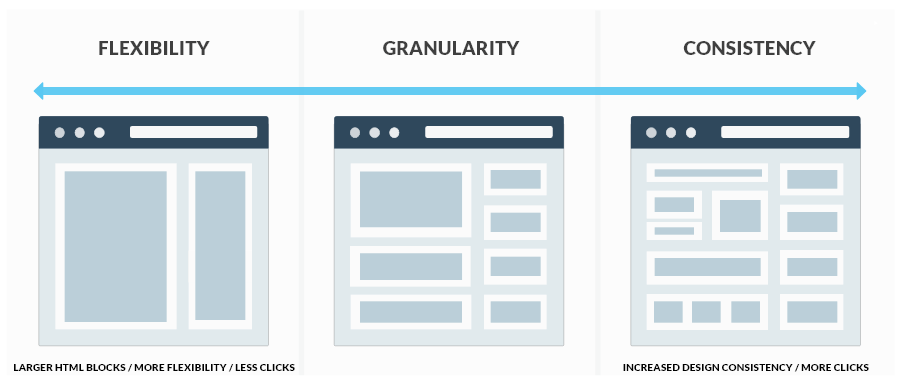One of the major challenges when implementing a site based on Sitecore CMS is determining how granular the templating and authoring should be. Decisions that the development team typically make in a vacuum have a large impact on the editor experience and adoption of Sitecore. Oshyn's approach is to facilitate a discussion as early as possible with the content editing team to determine how granular the fields of content are required to be.

Figure 1: Editing Granularity Discussion Diagram
On one end of the spectrum, the entire page is one big blob of text and users can do whatever they want. On the other end, each piece of text can be a separately managed component. Neither of these is desirable.
The typical way to have the conversation is to sit down with the editing team and draw boxes around their wireframes (virtually or in person) to discuss exactly what the implications of either decision are. The types of trade-offs we want the editing team to consider are:
- If it is too large a block of text, you won't be able to re-use one piece of it on a separate page or component.
- If it is too small a block, there will be lots of clicks to edit the different sections and add multiple components.
- How important and risky is consistency across pages? Larger blocks of content are more likely to require HTML skills to keep them looking nice and could be difficult to keep working without proper HTML/CSS skills.
- Higher granularity makes it more difficult to dramatically change the design on a page in the future.
Therefore, the questions the editors need to answer are:
- Where WILL we want to re-use this? Will we EVER want to re-use this exact piece of content?
- Do I or someone on my team have HTML skills to work in large blocks of content?
- What can you envision doing with this page / content in the future? If this page structure is static and future updates mean changing the content within the existing components, then you can make it more granular. If the page structure is volatile then making major changes will be easier if the page is less granular.
Figuring out the right balance is an art and is different for each customer, website and possibly even for different pages or sections of the site. This decision is important as editors will be living with the consequences of it for many months to come and is typically the difference between whether they end up liking and adopting the system or rejecting it for something else.


